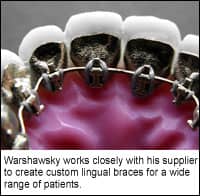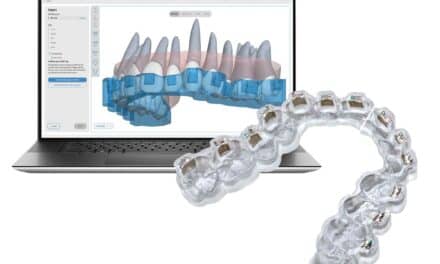by Anita D’Alessandro
Neil Warshawsky, DDS, attracts adult patients who are willing to pay a little more for orthodontic treatment that they can’t see

According to Warshawsky, his reputation for specializing in customized, invisible treatments has attracted a previously untapped clientele of adult patients. More than half of these patients have had braces before and are rarely, if ever, willing to give traditional mechanics a second try. What’s more, thanks to the Internet, many patients are highly educated about new developments in orthodontic treatment before they ever set foot in his office, and they specifically request his inconspicuous hardware.
OP: How many offices do you currently have in operation?
Warshawsky: We currently have four separate locations. Three of my offices are stand-alone offices in densely populated areas. The fourth office is at the University of Chicago. Of the four offices, only the first was planned from day one. The other three offices all happened by chance later on.
OP: Tell me about your background and education.
Warshawsky: I always wanted to be an orthodontist. My cousin was my inspiration, although he never strapped me up as a kid. He told me that my case was mild and that he would treat me if I went into ortho school. I honestly had no real idea of what an orthodontist did.
I completed all my education at the University of Illinois. When I finished my specialty certificate in orthodontics in 1992, I immediately opened my own practice in Chicago’s Lincoln Park area. Today, this is our main office and it continues to be the benchmark for what my practice can clinically achieve.
OP: What’s your position at the University of Chicago?
Warshawsky: I am the only orthodontist employed by the university. I am one of the cogs in the craniofacial team, and I teach surgical orthodontics in the plastic surgery department.
OP: How did your interest in lingual orthodontics begin?
Warshawsky: It was immediately apparent to me upon graduation that none of the practices in Chicago offered adult orthodontics beyond conventional therapy. My plan was simple. I wanted to learn to hide mechanics as much as possible. I figured that there had to be an entire market out there that did not want braces, but would consider them if they were not visible. I joined the lingual orthodontic society. I took the lingual course and read the books that were available. I went up to [a] lab, learned firsthand about setup systems, and started to do some serious cases with lingual braces.
Then, when I had around 25 cases in treatment at my practice, a local orthodontist sadly passed away and left behind a truly unique practice—it was 100% lingual. He had approximately 100 patients when I purchased the practice, and I completed all of these cases. This was probably the largest single factor that set our practice apart: We suddenly had a lot of lingual orthodontic patients. This influx of patients confirmed my earlier thinking, and setting our practice apart mechanically made it much more difficult for patients to “shop” our price against other practices. I found overall that this untapped crowd of adult patients was willing to pay a little more to get invisible mechanics.

Warshawsky: About 100.
OP: What is their age range?
Warshawsky: They range in age anywhere from 12–75.
OP: Are the patients who opt for lingual treatment mostly adults or mostly teens?
Warshawsky: Mostly adults.
OP: Once you’ve shared the benefits of using customized lingual braces versus traditional braces with your patients, do you find that that they are eager to go with the customized lingual braces system?
Warshawsky: Not necessarily. The Web does a miraculous job of educating people. Whether our patients start on our Web page and click through to the Web sites of our customized mechanics partners, or whether they Google their way to me, I feel that patients today often come in knowing what to ask for—if they did their homework. More than 50% of the adults we see have had braces before, so my general rule is that if they have relapsed, I do not implement the same style of mechanics. Keep the retainers on for life, pull teeth, do/augment with surgery, etc. I just make sure the mechanics are more effective than what was used the first time and retain, retain, retain each case!
OP: How do you customize each case?
Warshawsky: As my lingual experience continued over the years, we grew to be recognized as the lingual office in and around Chicago. It really had become something that we were very familiar with. However, as I became more familiar with the system, I also grew increasingly dissatisfied with some of [its] flaws.
Since we had become one of the largest users of the system in the country, the lab that did my setups told a custom lingual supplier in Dallas about me. They contacted me, and when I heard their presentation, my immediate response was that I needed to go to Germany to meet with the doctor who had helped them develop the system.
Three weeks later, I went to Germany, and we have been ordering cases ever since. Somewhere along the way, [other] companies also came along, so now keeping with the theme of trying to appease the adult crowd, we offer a total of nine separate types of orthodontic appliances. Either way, my mission statement is truer today than ever. “I am going to deliver 100% customized mechanics to my patient in a comfortable, professional, and pleasant atmosphere.” My mechanics can range from custom lingual down to limited removable therapy. But with every patient, my approach will still be the same. I will always attempt to customize my mechanics to hide them and efficiently move teeth all in the same swoop, where possible.
OP: Does using lingual braces affect treatment time?
Warshawsky: It does on deep-bite cases. Another thing it does is that I don’t hear, “When are my braces coming off?” every five minutes. We make patients’ front teeth look really good in the first few months and earn their trust.
OP: How much of an issue is patient comfort?
Warshawsky: With the custom cases, comfort is not an issue. In fact, I’ve had custom lingual braces for a year. Nobody knows. It doesn’t make me talk differently, it doesn’t stop me from eating anything. If your patients say they’re comfortable, then it works.
OP: Do you have any tricks to help patients feel more comfortable?
Warshawsky: It may seem obvious, but we put the lower teeth on first, because 99% of discomfort is the lateral border of the tongue rubbing against the first lower molar. We tell patients it will take a week to 10 days to get comfortable. And if we need to, we apply a light-cured periopack to the area that’s bothering the patient. That takes care of the problem and, because it’s on the lingual, you can’t see it.
OP: Did your customized lingual braces vendor offer training?
Warshawsky: Yes, they provided us with a comprehensive set of material, including full-color training manuals. In a few hours, you have enough information to successfully bond your first case with little to no problems. There is a lot of online support, including video, but if you are still uncomfortable, they now offer live training around the country as well as personalized troubleshooting in the comfort of your own office.
When our first case was delivered, the company offered to send their clinical trainer to my office to observe us install the case, and advised us on ways to make it easier to do the next case. I frequently get on the company’s monthly conference call to Germany to discuss our latest tips and tricks. They, in turn, give me theirs, and I have found that the system is really great to get rid of problems before they start. You have to admit that it is ironic that over 99% of the retail orthodontic market is labial mechanics, but the most highly precise system out there today happens to be custom-made brackets and wires for the lingual.
Anita D’Alessandro is a contributing writer for Orthodontic Products.










